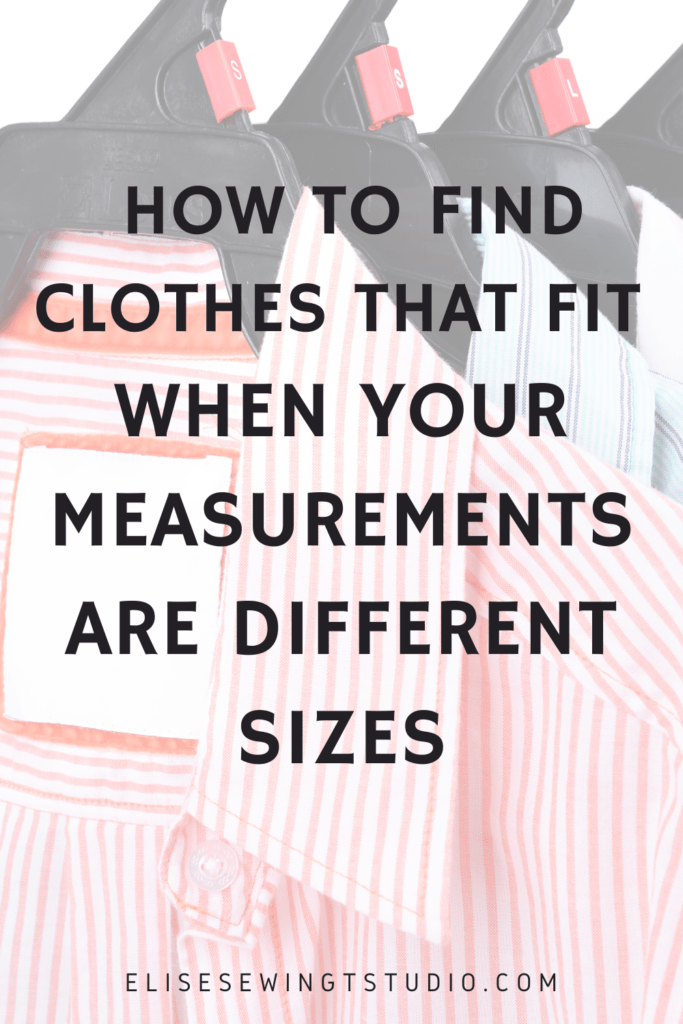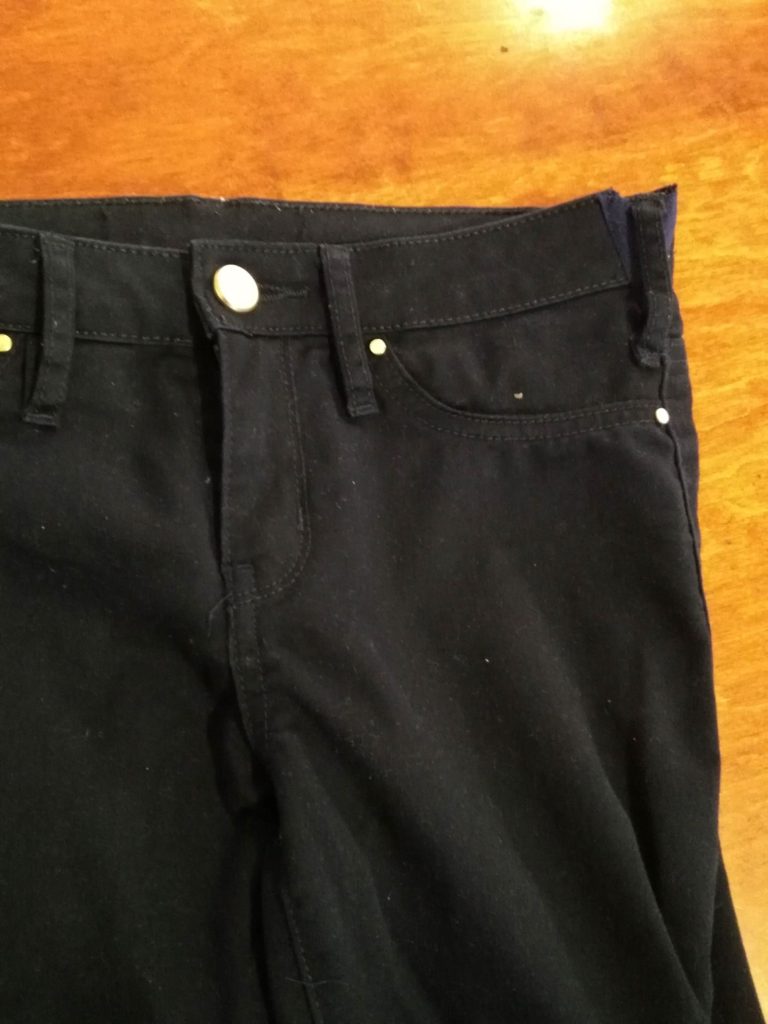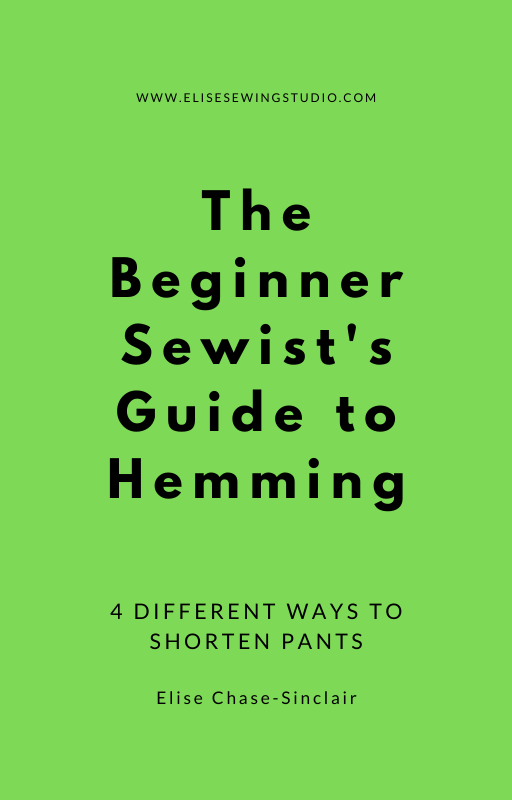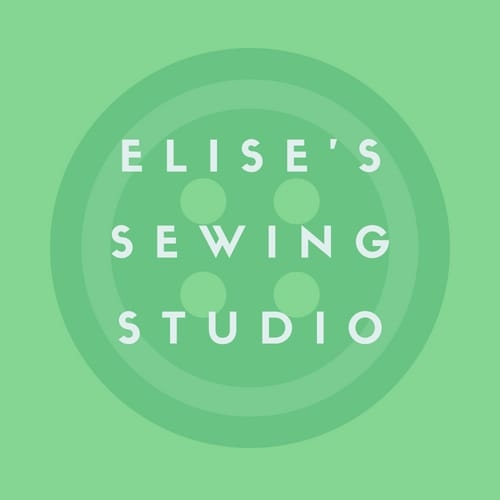We are a participant in the Amazon Services LLC Associates Program, an affiliate advertising program designed to provied a means for us to earn fees by linking to Amazon.com and affilated sites. We may earn money or products from the companies mentioned in this post.

Or: Standard sizing & shopping: how I find clothes that work when my measurements are in different sizes.
First of all….who has gone clothes shopping and been frustrated that they can’t find something that fits right?
I sure have, especially with jeans. I’ll get into my story in a minute.
You may have noticed that you have better luck getting a better fit at one store, but there is another store you have stopped going into – maybe the waist is too big when it fits your hip, or there is something about the rise that just doesn’t work for you, or any other number of reasons it just doesn’t work out.
How size charts for clothing work
Brands use a size chart as a guide when they make their clothing sizes. This is a guide of “average” measurements for a particular size that their clothes are intended to fit. A pattern drafter utitlizes these measurements while making patterns for the clothes the store sells.
Which is ok – except when your measurements fall in different sizes (which mine do). And to state the obvious, humans come in all sorts of different proportions, and it’s hard to actually make sizes that fit everyone. So, please just remember that sizes are groups of numbers that someone tried to group together to make a clothing size to fit an average body, and if your measurements are in different sizes, you are not alone.
If you want to dive deeper into this subject, there is an interesting article on the site My Green Closet, by the writer who did her own study and found that most people’s measurements don’t fit into one size.
Finding your best size when clothes shopping
First of all, let’s just take a moment to recognise that different countries use different sizes, and sewing patterns again use different sizes, AND different brands use different measurements in their sizing – it is not universal.
As a general rule, when looking at a size chart it’s best to go with the largest size your measurements fall into, and then alter it. Unless….
I recently decided that I wanted a new pair of jeans and went looking online. I haven’t bought new jeans in a while. I have a very rectangular shaped lower body and struggle with finding pants that fit me. I’ve tried on pants that have been too tight in the waist while simultaneously being too big in the hip. I took my measurements and…between my hip, thigh and waist….my sizes based on my measurements had me in a 2, 4 and 10.
I didn’t buy anything.
Instead, I altered a pair of pants that had been abandoned in my wardrobe by adding fabric at the waistband, and have now decided to wear more skirts.

For myself, I find skirts much easier to fit – I buy them so the waist is comfortable and then if I decide I want to take it in over the hip, I do so. Like I did in this tutorial, How to Make a Skirt Fit Smaller. But if the skirt is more flared around the hip, I usually just leave it.

Waist to hip ratio, and what curvy means in terms of clothing cut
The definition of the word “curvy” has nothing to do with the size you are, and everything to do with your waist to hip ratio. I have a smaller waist to hip ratio, with my hips only about 5″ smaller than my waist. I’m rectangular, or a straight body. Straight and curvy bodies can be any size. Curvy means a greater difference between you hip and waist measurement – there’s more a curve between your waist and hip. Demi curve is in the middle, and women with this shape tend to have an easier time fitting into size charts.
Some brands have started to make different cuts to help fit differently shaped bodies better, you may want to try on the different cuts (“straight” or “curvy”) to see what the difference is on you. So a curvy cut will be more nipped in at the waist to help with those who get a back gap, and a straight cut is better for a straighter body.
Tailoring can help solve clothes that aren’t made for your body.
This is where good tailoring can come into play. I like to tailor my own clothes – and because I can, it makes shopping for clothes easier. I feel like alterations in the online sewing space are seen as being boring or annoying (“I don’t hem pants!” memes for example). But for me, I am thankful that I have the know how and resources to take more control over how my clothes fit me, especially since my measurements rarely fit into one size on a size chart.
I’d rather make my clothes fit me, instead of trying to make myself fit into clothes that weren’t designed for how I am. This is my mission – to teach people how to do their own clothing adjustments so they don’t have to get frustrated going clothes shopping or give up on finding something that makes them feel good to wear.
If doing your own clothing adjustments isn’t something you see yourself doing. try and find a local tailor in your area.
Size Charts and Sewing Patterns
If you buy sewing patterns, please be aware that the sizes for sewing patterns are not the same as those in store. The size number is larger than your dress size number in US/Canadian clothing sizes. Take your measurements, and forget about whatever size you think you should be and go with the size chart.
Generally, if your measurements fit in different sizes, it is easier to go with your biggest size and then take the clothing in or adjust the pattern. Pattern adjustments are a skill to learn and take some practice, but it does help get a betting fitting garment quickly. If you are less experienced, it is best just to make it in the bigger size and take it in, perhaps making a mock up in inexpensive fabric first to make any fitting adjustments before using nice fabric.
If you would like to start doing your own alterations but don’t have a lot of experience with it, I recommend starting with learning different ways to hem your clothes. I have an ebook available The Beginner Sewist’s Guide to Hemming, which shows you how to hem your clothes 4 different ways.

Want to learn more about altering clothes you already have, to fit your unique body and style? Receive my free guide full of tips to get you started doing your own clothing adjustments by signing up to my newsletter here.
Please leave a comment if you would like to share your experience with this subject, or any questions.

2 responses to “How to use size charts for women’s clothing”
This is great! I love your comment about wanting to make your clothes fit you instead of you fitting into your clothes. The inconsistency of clothing sizes can be so frustrating and unfortunately too often for young women can lower your self-esteem. Growing up my mom would cut out the tags of our clothes so we would not worry about the size, but be more focused on clothes that fit us well.
Hi Hannah, wow it is interesting that your mom cut the size out of your clothes! What a great idea.